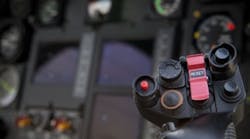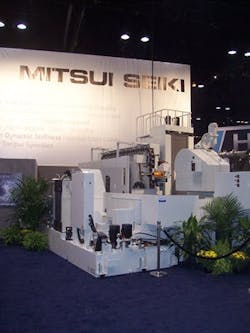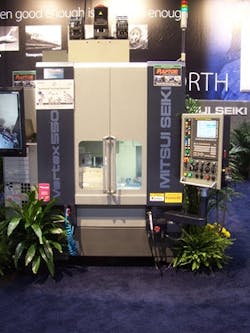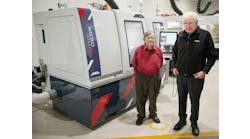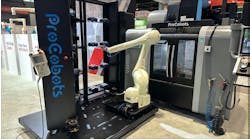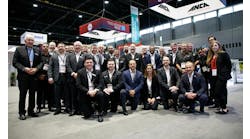Jim Montague is the executive editor for Control. Email him at [email protected].
When end users need machine parts, they go to their suppliers; when suppliers need parts and equipment, they ask their machine builders. So, where do builders find specialized components and devices they can't get anywhere else? They go to Mitsui Seiki USA in Franklin Lakes, New Jersey.
This is not an idle sales boast. The 33-year-old U.S. subsidiary and its 87-year-old parent company, Mitsui Seiki Kogyo in Kawajima, Japan, is one of just a few firms whose equipment enables users to do high-precision machining of the hardest types of titanium, tungsten and new intermetallic composites like titanium aluminide (TiAL). The parts that Mitsui Seiki's machines produce are used to build everything from other machine tools and critical power-generating components to next-generation aircraft engine turbines and landing gear.
"We aren't the biggest machine builder, but our core competency is precision in serving OEMs and the machine tool market," says Scott Walker, president of Mitsui Seiki USA. "As a result, we have to maintain one decimal place more accuracy than other builders because our machines are often used to manufacture many of the parts that go into their machines. Because we also lead in R&D and special applications, we can change designs for tapers, tools and controls and build whatever our customers want within any size range."
Also Read: Hand Scraping Sets the Foundation for CNC Machining Accuracy and Long-Term Stability
Mother Machines
Long based in Tokyo, Mitsui Seiki started making measurement instruments such as block gauges and micrometers in 1928, but it developed its first medium-sized, jig-boring machine in 1935, which meant Japan no longer had to rely on imports. It was called the nation's first "mother machine" because it was mostly used by other tool builders to make critical components for their machines, and it helped to establish Japan's machine tool industry. Presently, Mitsui Seiki offers jig borers, jig grinders, horizontal and vertical machining centers, five-axis machining centers and screw grinders, all of which support builders and other users worldwide.
Mitsui Seiki's HU100-5X horizontal, five-axis machining center was recently updated with new Fanuc 31iM controls and a new spindle interface to improve cutting of titanium landing gear parts.
To achieve and maintain the order-of-magnitude better precision that its mother machines require, Mitsui Seiki must reduce vibrations, temperature and humidity changes and other adverse ambient conditions in its manufacturing areas. As a result, it incorporated some unique environmental attributes when it built its main plant in Kawajima in 2001. The factory's 1,700 pilings go 120 ft deep into the remote site's bedrock, while its floors are 4 ft thick in critical areas and 3.28 ft thick elsewhere. A laminar-flow air-conditioning system exchanges air in the factory 24 times/hr but still ensures a uniform, floor-to-ceiling temperature of 68 °F with ±9 °F accuracy and humidity of 55% with ±5% accuracy.
"We even have our own foundry, make our own spindles and tools and build our machines in place," says Bob Anderson, Mitsui Seiki's senior applications engineer. "This gives us better control over the accuracy of our machines."
New Controls, Hand Scraping
To keep improving its precision while meeting end users' needs at the same time, Anderson reports that Mitsui Seiki recently updated the controls on its HU100-5X horizontal, five-axis machining center (Figure 1).
"We been building this machine for 20 years, but now its Fanuc 31iM controls and spindle interface are all new," adds Anderson. "This interface has to be extremely stiff and rigid because the geared spindle on the HU100-5X and our other machines run at low rpm and very high torque because they need to make deep cuts and get out fast."
Ideal for making larger aerospace and power-generation parts, HU100-5X has an XYZ workzone capacity of 1,500 by 1,200 by 1200 mm, and it accommodates material weights up to 4,400 lb. It also includes a maximum spindle torque of 2,000 ft-lb, an HSK 125A tool taper, dual-pallet changer, automatic workpiece/fixture measuring and compensation system, non-contact-laser tool setter, 3D tool compensation and dynamic feature offset.
Walker adds that HU100-5X is used to cut 553 and 1023 titanium for critical parts of the landing gear on Boeing's aircraft. It can typically cut about 100 units for landing gear per year over a projected 25-year lifecycle. However, the extreme weight of the machine and its workpieces require some special treatment to maintain precision. "The machine assembly and its parts can weigh about 75,000 lb, so it can flex downward as it moves along its x-axis," explains Walker. "We have to hand-scrape the machine's platform to compensate for this flexing, and hold it to its 25-micron true position in the work envelope."
Lighter Engines
Mitsui Seiki's constant machine improvements and updates are also needed to keep up with continually evolving material and capability changes and resulting shifts in customers' requirements, explains Walker.
"Trends in engineering are taking us and our clients into new classes of technology," says Walker. "For example, we recently helped to develop GE's LEAP high-bypass, turbofan engine, which will be 20% more efficient but has new designs and uses new materials like titanium and plastic composites, which need to be machined using new controls for their tool paths and edges. That's what we do. Right now, we're the only company that can cut TiAL, which is used in the LEAP engine's gear and fans. Typically consisting of about 16% aluminum, TiAL is lighter and stronger, can withstand heat better, can reduce an engine's weight by 20% and can make it 20% more fuel efficient."
Mitsui Seiki's Vertex 550 uses 99.9% diamond-coated tooling from DTS to cut titanium-aluminum (TiAL) quickly, while still maintaining a good blade profile and surface finish.
To help GE to migrate its flight engine fleet to LEAP and build about 25,000 units by 2025, Mitsui Seiki recently developed its Vertex 550 five-axis machining center in conjunction with Diamond Tooling Systems in Kaiserslautern, Germany. Vertex 550 is managed by Fanuc 31iB5 controls (Figure 2). DTS makes tooling with a 99.9% diamond-based coating that's applied in a vacuum-reactor process that needs almost no binder material, so it can achieve about 10 times better tool life than current polycrystalline diamond tools.
"There are 144 fan blades on a new aircraft engine, and each one usually costs about $2,500, including about $800 for raw materials," explains Walker. "So, there's also been an effort to reduce these costs, and that’s why we invited DTS to help with our tooling, fixtures and coolant system. The goal here is to maintain good leading and trailing edges when cutting. Thanks to DTS's tools, Vertex 550 can cut at about 200 in/min and hold a good blade profile, or cut 58 in/min with a better surface finish.
"Balancing our machines and their motion controls in this way allows them to run both dynamically and accurately. For instance, if you've got 5 seconds to cut 3 inches, then you also have to manage your acceleration and deceleration. That's dynamic movement. However, it also means telling the Fanuc controller the right tool path, so the overall machine it can run precisely."
Walker speculates that Mitsui Seiki will continue to be at least as busy if not busier than it is now because everyone from machine builders to end users will keep coming up with new materials they want to machine; fracking and ultra-deep process applications need parts, and the world is on the cusp of an aerospace renaissance. "Especially in India and China, airlines are going to want more aircraft, and we're also going to see more transonic and low-subspace travel, and all of these vehicles are going to need engines, landing gear and other crucial components," adds Walker.
